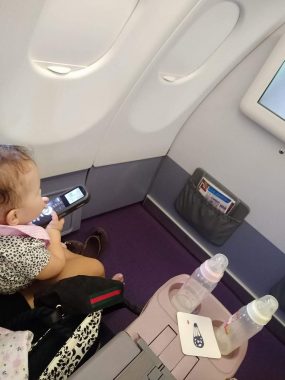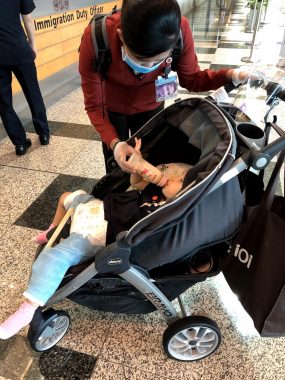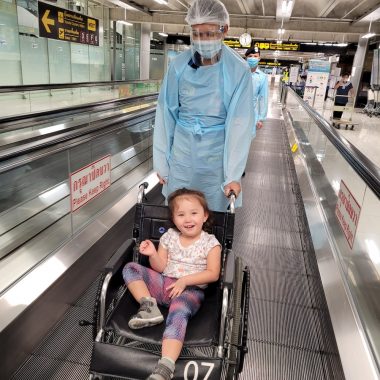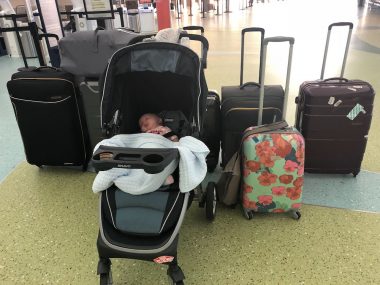Airline Travel Tips for Children With Special Needs

Airports are notorious for their challenging security and health requirements. Parents of children with special needs may find the thought of airline travel too daunting to even try it.
However, we’ve done it three times on international trips with our young daughter, who has aromatic l-amino acid decarboxylase (AADC) deficiency, and recently completed a journey to see her grandma. Here’s how we made it easier each time.
Booking tickets
When booking tickets, try to avoid booking online or with agents. The best choice, in our experience, has been calling the airlines directly. There was no significant difference in price, but talking directly with the airlines lets you quickly discover all the benefits available.
Be sure to ask about discounts and special arrangements for traveling with someone with special needs. These could include preferred seating or lounge perks. Don’t be afraid to ask. Only when you ask shall you receive.

Rylae-Ann and her mother enjoy some extra space, secured by asking the airline during booking. (Photo by Richard E. Poulin III)
Airline counter
If you see a long line when going to the counter, check the signs there. We’ve been allowed to check in at the first-class line or special assistance counter. If you’re unsure, look for a representative and explain your situation. Each time the receptionists provided much-appreciated help.
My wife once had to travel alone with our daughter. At no extra charge, the airlines arranged for an assistant to help them get all the way to the plane, and an assistant was waiting when they got off the plane, as well.
At the counter, you can also request wheelchair assistance if you prefer. We always brought our stroller, which was much more comfortable than the airport wheelchair. However, if you don’t feel like handling the extra hassle of a stroller, then use the airport wheelchair. It’s one less thing you have to worry about.

An airline assistant feeds Rylae-Ann while her mother uses the bathroom on a trip when the two were traveling by themselves. (Photo by Richard E. Poulin III)
Security checkpoint
A porter or other wheelchair assistance will take you to a separate line for a security check. Everyone in your traveling party will be able to use this area. Each time we’ve traveled, it has been a much faster process. There are fewer people, and you feel less stressed.
During security checkpoints, have documentation ready about traveling with medications. Our doctor provided us with a letter, but strangely we were never questioned. The Transportation Security Agency (TSA) advises that all medication be clearly labeled in its original packaging.
Our snacks and liquids were always checked. The airports have clean and free water-filling stations, so you don’t have to buy expensive bottled water. We just dumped the liquids before security and then refilled the bottles afterward.
The security agents were always helpful and understanding when placing our daughter through the detectors. All metal will need to be removed, though. Do your best to travel with only the necessary items.
I recommend everyone wear easy-to-remove shoes, comfortable pants that don’t require a belt, and no jewelry. Finally, be ready to take out any laptops or tablets.

An airport wheelchair porter helps to escort Rylae-Ann and her family through a special security line at the airport. (Photo by Richard E. Poulin III)
Boarding gate
At the boarding gate, you can ask the attendants about priority boarding. They’ll have this, but by asking, they’ll know your face and be ready to help. If you have a porter, they will handle this for you. This will also be the time when they take your stroller. Don’t worry; it’ll be ready for you once you land.
Before boarding, I prefer to use the bathrooms at the airport. The handicapped bathrooms will give you plenty of space to change your child. Take advantage of this space as well because, as the caregiver, you will need to be as comfortable as possible.
On the plane
Getting on early helps you get settled and comfortable. Rely on the flight attendant to help with getting anything in the overhead luggage compartments. I prefer to have everything in a book bag that can fit underneath the seat in front. That way, everything is right at my fingertips.
In the bag, you should have a change of clothes for everyone, a plastic bag to throw away any dirty clothes, and plenty of wet wipes. Our daughter puked on me during one flight. We went to the bathroom, and everything went in the bag and straight into the trash. The extra pair of clothes works out well in case your luggage gets lost or you are delayed at the airport.

Check in as many suitcases as possible so you can board the plane with as little as possible. (Photo by Richard E. Poulin III)
Leaving the plane
When leaving the plane, I wait until everyone else is off. If you have wheelchair assistance, the flight attendants will likely ask you to wait until everyone is off, anyhow. This extra time also allows the airlines to prepare your stroller so you don’t have to wait. After leaving the plane, again we used the airport handicapped bathroom, instead of the plane’s closet restroom.
Travel and make memories
Traveling by air may seem a daunting experience, but it doesn’t have to be. With some planning, you can access benefits and amenities that will make the experience much more enjoyable for your child and yourself as a caregiver. Check on the latest travel advisory and follow protocols to reduce COVID-19 exposure. That way, you can continue making memories, traveling, and visiting families.

Rylae-Ann and her mother follow safety precautions to reduce their chances of contracting COVID-19 while flying. (Photo by Richard E. Poulin III)
Note: AADC News is strictly a news and information website about the disease. It does not provide medical advice, diagnosis, or treatment. This content is not intended to be a substitute for professional medical advice, diagnosis, or treatment. Always seek the advice of your physician or other qualified health provider with any questions you may have regarding a medical condition. Never disregard professional medical advice or delay in seeking it because of something you have read on this website. The opinions expressed in this column are not those of AADC News or its parent company, Bionews, and are intended to spark discussion about issues pertaining to aromatic l-amino acid decarboxylase deficiency.








Leave a comment
Fill in the required fields to post. Your email address will not be published.